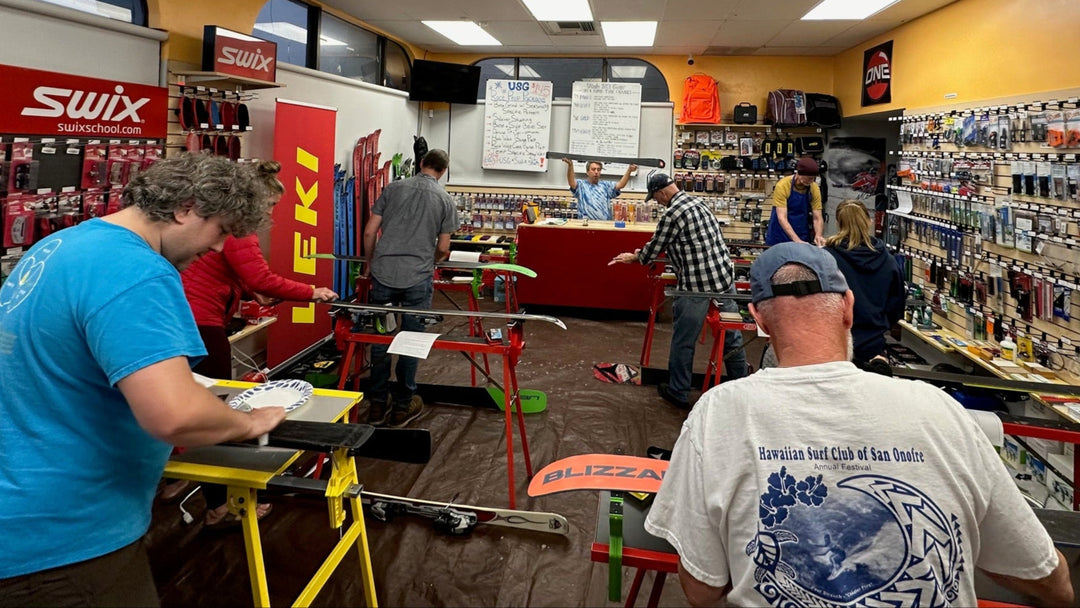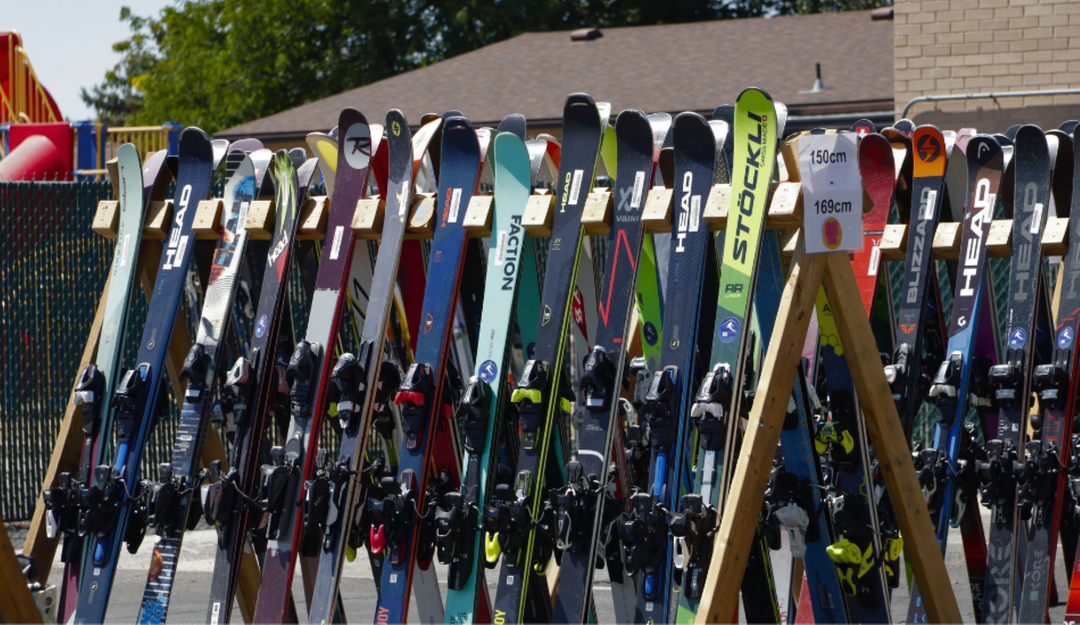Beginners Guide to Ski and Snowboard Gear
What Ski Gear Do I Need? All of your Ski and Snowboard Equipment Questions Answered
When you first start to ski or snowboard, the equipment and clothing you need may seem overwhelming. You may be asking yourself, what ski gear do I need? Luckily we're here to help with that. Starting from the feet up, we have broken down all of the necessary equipment and clothing that you need to start skiing or snowboarding!
Ski Socks ✓

Ski socks should be tall enough that they fully come out of your boots. This will help eliminate bunching and provide more comfort in the boot. Ski socks should be high-quality wool, synthetic, or wool and synthetic blend. Cotton ski socks will not provide the moisture control or warmth that a ski sock provides. Ski socks must also be the right thickness for your boot. A thin sock is great for adults breaking in boots, but kids could start off with a thicker sock, and then switch to something thinner as they grow. High-quality socks like Vermont's Darn Tough also come with an unconditional lifetime guarantee and will help keep your feet warm.
Boots✓
Boots are one of the most important pieces of ski equipment. You want your boots to fit tightly, but also be comfy enough for you to ski all day. Test out the flex on the ski boot and ensure that you can easily flex into the front without bending over. As your ability increases, you will want to look for stiffer ski boots. Some ski boots also feature a walk mode, which can be nice for walking around the resort. Alpina boots offer a heated boot with an automatic heating system built into it, which is great for colder days. However, if you like the comfort and fit of your current boot, Hotronic and Thermic foot warmers can be added to any ski boot.
Baselayer ✓
It is important that your base layers are a synthetic and/or wool blend because these are the best wicking materials. Base layers are meant to help reduce sweat build up so this is an essential element in choosing a base layer. Base layers vary in thickness, so choose the best weight for your activity and warmth level.
Snow Pants ✓

Snow pants can either be insulated or uninsulated, depending on your preference. When looking for ski pants, try to purchase pants with Gore-tex or a high-quality brand-specific alternative. This will likely be more expensive, but it will better protect you against the wind and the rain. Gore-tex is also extremely breathable, which will help you stay warm. When choosing your snow pants, make sure you have enough room for mobility. Ski and snowboard pants should also have an elastic gaiter at the bottom to keep snow out of the pants. Additionally, the pants should reach the bottom up your feet to ensure that they will not ride up above your boot on the chairlift.
Gloves ✓

Gloves are often disregarded when shopping for ski clothing, but they are extremely important. Warm hands will significantly improve your experience while skiing or snowboarding. For maximum warmth, choose leather gloves. These will repel the water and insulate your hands better. Leather gloves are also more durable and less likely to become cut up while carrying your ski or snowboard edges. Gloves also come in mitten form, where all of your fingers are together, rather than separated. Mittens do not provide as much mobility and performance, but they are warmer. Most companies also offer a hybrid, where your fingertips are separated, but the rest of your fingers are connected to increase warmth. Some gloves have a gauntlet that helps protect the wrists from the cold and snow. This is especially nice for kids, and SnowStoppers makes a great ski glove for children with an extended gauntlet that prevents any snow from entering.
Poles ✓

If you're just beginning, a basic ski pole will work as long as it fits. As you become more advanced, you may want to choose your poles based on their weight, strength, or pole basket. The bigger the pole basket, the better the ski pole will be in powder. Carbon or fiberglass ski poles will be a lighter weight than aluminum ski poles, but they will also be more expensive.
Insulating Layer ✓

An insulating layer goes between your base layer and your outer ski layer. This layer is intended for warmth, but will not have the weather protection that a ski shell will have. An insulating layer depends on the warmth needed. A light fleece jacket can work in some conditions while other times may require a down jacket. Moisture-wicking is still important for insulating layers, but not as important as it is for baselayers. You can also wear multiple insulating layers if you run cold or the weather outside is extra cold.
Jacket ✓
Choosing a jacket is very similar to choosing ski pants. Look for high quality and durable materials to adequately protect you from the weather conditions. Ski-specific jackets will usually have a powder skirt, armpit zippers, and inside pocket for storing goggles or additional items. Snowboardi jackets will be a little bit longer in order to provide warmth when sitting down and tightening buckles.
Gaiter ✓

A lot of people may forget that they need a gaiter or neck protector, but this leaves their neck and face unprotected from the sun, winder, and cold temperatures. Gaiters can either be a synthetic material or merino wool and they vary in thickness. Using a neck and face protector is the best way to avoid frostbite on the face. This occurs frequently in sub-20 degree weather. Some people like traditional gaiters, which cover your neck and your lower face, while others prefer a balaclava that cover their entire head. Balaclavas provide more warmth, but can also feel restricting. Turtle Fur offers a variety of types of neck warmers, depending on your preference.
Helmet ✓

Helmets not only provide protection, but they supply warmth as well. Unlike biking helmets, ski helmets have ear flaps, which assist in keeping you warm. Skiing and snowboarding is a dangerous sport, and wearing a helmet is necessary for eliminating potential risks. Some helmets have a clip for your goggles, which can be extremely useful. For younger kids and toddlers who are just starting out, the Doodlebug by Lucky Bums is very popular because of its durability and fun patterns. A lot of ski helmets have a boa style tightening system allowing for you to easily adjust the size so the helmet fits you snugly but does not hurt. Having an adjustable helmet is useful for growing kids and allows the option to occasionally wear a balaclava or thin hat under your helmet.
Goggles ✓

Goggles provide crucial sun protection and warmth. They vary in shape, so pick the one that best fits your face and helmet. Try to eliminate any gap between your helmet and the top of your goggles as this gap will allow for cold air to penetrate your forehead. When choosing your goggles, it is important to choose a lens that will fit your skiing behaviors. For night skiing you want a clear or very light lens because you need to be able to see the snow in the dark. For daytime skiing, you need a darker lens that can help reflect the sun. If you prefer to have multiple lenses, brands like Smith sell replacement goggle lenses that are easy to switch out and exchange. There are also a few high-end goggles that have color-changing lenses for varying light conditions.
Skis/Snowboard ✓

Perhaps the most obvious equipment piece needed, skis and snowboards are a necessity for winter sports. Make sure your skis and snowboard are the right length and stiffness for you. Additionally, make sure the bindings have been correctly adjusted for your body and boot measurements. While skis and snowboards are very central to the sport, you need to make sure your body is comfortable and warm, or you will not want to leave the lodge.
There are quite a few things you need for skiing and if any of your equipment needs to be replaced, Utah Ski Gear sells discounted new and used gear online and in-store at 9400 S 600 E, Sandy, UT.






